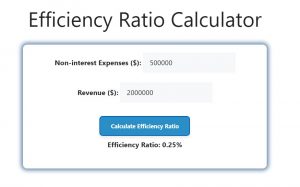About Efficiency Ratio Calculator (Formula)
The Efficiency Ratio Calculator is a valuable tool for evaluating the operational efficiency of businesses, particularly in the banking and financial sectors. It measures how well a company manages its non-interest expenses compared to its revenue. A lower efficiency ratio indicates a more efficient company, while a higher ratio suggests inefficiency. Understanding this ratio can help businesses streamline their operations and improve profitability.
Formula
The formula to calculate the efficiency ratio is:
Efficiency Ratio (ER) = (Non-interest Expenses / Revenue)
Where:
- Non-interest Expenses are the company’s operating costs excluding interest-related expenses.
- Revenue is the total income generated by the company, often before taxes and expenses.
How to Use
To use the Efficiency Ratio Calculator, follow these steps:
- Determine the company’s Non-interest Expenses. These typically include administrative, personnel, and operational costs, excluding interest-related costs.
- Find the company’s Revenue. This is the total income earned before any deductions.
- Input these values into the calculator.
- The result will show the Efficiency Ratio, which helps you understand how well the company is controlling its costs relative to the income it generates.
Example
Let’s calculate the efficiency ratio for a company that has $500,000 in non-interest expenses and generates $2,000,000 in revenue.
Using the formula:
Efficiency Ratio (ER) = (Non-interest Expenses / Revenue)
Substituting the values:
Efficiency Ratio (ER) = $500,000 / $2,000,000 = 0.25 or 25%
This means that for every dollar of revenue, the company spends 25 cents on non-interest expenses, indicating good operational efficiency.

FAQs
- What is the efficiency ratio?
The efficiency ratio measures how well a company manages its non-interest expenses in relation to its revenue. - What is considered a good efficiency ratio?
A lower efficiency ratio is better. In the banking sector, an efficiency ratio under 60% is typically considered good. - Why is the efficiency ratio important?
It helps businesses assess operational efficiency, allowing them to see how effectively they control costs relative to their income. - What are non-interest expenses?
Non-interest expenses are the costs associated with running a business, excluding interest-related costs such as loan interest or financing costs. - Can I use this calculator for any industry?
Yes, although it’s primarily used in banking and financial services, the Efficiency Ratio Calculator can be applied to any business to measure operational efficiency. - What does a high efficiency ratio indicate?
A high efficiency ratio suggests that a company is spending too much on non-interest expenses relative to its revenue, indicating inefficiency. - How can a company improve its efficiency ratio?
Companies can improve their efficiency ratio by reducing non-interest expenses, increasing revenue, or both. - Is revenue the same as profit?
No, revenue refers to the total income a company earns, while profit is the income left after deducting all expenses. - How does the efficiency ratio affect profitability?
A lower efficiency ratio typically means lower operating costs, which can lead to higher profitability. - What is the difference between interest and non-interest expenses?
Interest expenses are costs related to borrowing money, while non-interest expenses are the day-to-day operating costs of the business, excluding interest payments. - Can this calculator be used for personal finance?
This calculator is mainly for business use, but it can help in evaluating how efficiently personal or household expenses are managed in relation to income. - How does the efficiency ratio relate to other financial ratios?
The efficiency ratio complements other financial ratios like the profit margin or return on investment, offering a more complete picture of a company’s operational health. - Why is it important to exclude interest expenses from the formula?
Excluding interest expenses helps focus the efficiency ratio on operational costs, allowing businesses to assess how well they manage routine expenses. - How frequently should companies calculate their efficiency ratio?
Companies typically calculate their efficiency ratio on a quarterly or annual basis, depending on the frequency of financial reviews. - What happens if the efficiency ratio is too high?
A high efficiency ratio can indicate inefficiency, leading to higher operational costs and potentially lower profitability. - Can this ratio vary significantly across industries?
Yes, the ideal efficiency ratio can vary depending on the industry, with certain sectors having higher or lower benchmarks for what’s considered efficient. - What are some common non-interest expenses?
Common non-interest expenses include salaries, rent, utilities, supplies, and administrative costs. - What does a 100% efficiency ratio mean?
A 100% efficiency ratio means that the company’s non-interest expenses equal its revenue, indicating that the company is not generating profit after covering operational costs. - How do financial institutions use the efficiency ratio?
Financial institutions use the efficiency ratio to assess how well they are managing their operating expenses relative to the income they generate from banking activities. - What other financial metrics should be analyzed with the efficiency ratio?
Along with the efficiency ratio, businesses should analyze profitability ratios, liquidity ratios, and debt ratios to get a complete financial picture.
Conclusion
The Efficiency Ratio Calculator is a critical tool for businesses to assess their operational efficiency by comparing non-interest expenses with revenue. A lower efficiency ratio indicates better control of operational costs, which can lead to improved profitability. By using the simple formula Efficiency Ratio (ER) = (Non-interest Expenses / Revenue), businesses can identify areas for cost reduction and revenue growth, ultimately improving their financial health.
